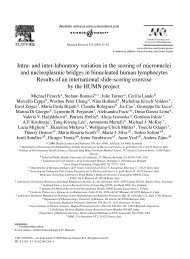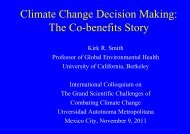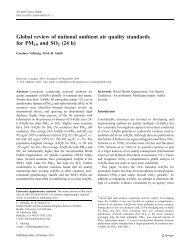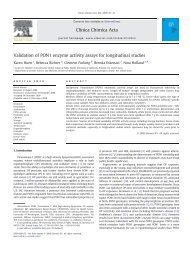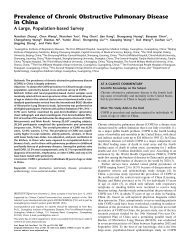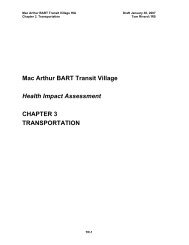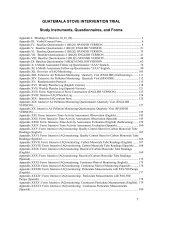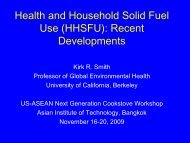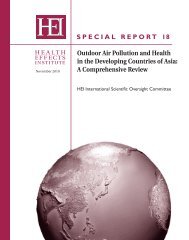The burden of disease from indoor air pollution - Environmental ...
The burden of disease from indoor air pollution - Environmental ...
The burden of disease from indoor air pollution - Environmental ...
- No tags were found...
Create successful ePaper yourself
Turn your PDF publications into a flip-book with our unique Google optimized e-Paper software.
Int. J. Hyg. Environ. Health 206, 279 ± 289 (2003)¹ Urban &Fischer Verlaghttp:// www.urbanfischer.de/journals/intjhygInternational Journal<strong>of</strong> Hygiene and<strong>Environmental</strong> Health<strong>The</strong> <strong>burden</strong> <strong>of</strong> <strong>disease</strong> <strong>from</strong> <strong>indoor</strong> <strong>air</strong> <strong>pollution</strong> in developingcountries: comparison <strong>of</strong> estimatesKirk R. Smith, Sumi Mehta<strong>Environmental</strong> Health Sciences, School <strong>of</strong> Public Health, University <strong>of</strong> California Berkeley, California, USAReceived December 16, 2002 ¥ Revision received January 10, 2003 ¥ Accepted January 13, 2003AbstractFour different methods have been applied to estimate the <strong>burden</strong> <strong>of</strong> <strong>disease</strong> due to <strong>indoor</strong> <strong>air</strong><strong>pollution</strong> <strong>from</strong> household solid fuel use in developing countries (LDCs). <strong>The</strong> largest number<strong>of</strong> estimates involves applying exposure-response information <strong>from</strong> urban ambient <strong>air</strong><strong>pollution</strong> studies to estimate <strong>indoor</strong> exposure concentrations <strong>of</strong> particulate <strong>air</strong> <strong>pollution</strong>.Another approach is to construct child survival curves using the results <strong>of</strong> large-scalehousehold surveys, as has been done for India. A third approach involves cross-nationalanalyses <strong>of</strong> child survival and household fuel use. <strong>The</strong> fourth method, referred to as the`fuel ± based' approach, which is explored in more depth here, involves applying relative riskestimates <strong>from</strong> epidemiological studies that use exposure surrogates, such as fuel type, toestimates <strong>of</strong> household solid fuel use to determine population attributable fractions by<strong>disease</strong> and age group. With this method and conservative assumptions about relative risks,4 ± 5 percent <strong>of</strong> the global LDC totals for both deaths and DALYs (disability adjusted lifeyears) <strong>from</strong> acute respiratory infections, chronic obstructive pulmonary <strong>disease</strong>, tuberculosis,asthma, lung cancer, ischaemic heart <strong>disease</strong>, and blindness can be attributed to solid fuel usein developing countries. Acute respiratory infections in children under five years <strong>of</strong> age arethe largest single category <strong>of</strong> deaths (64%) and DALYs (81%) <strong>from</strong> <strong>indoor</strong> <strong>air</strong> <strong>pollution</strong>,apparently being responsible globally for about 1.2 million premature deaths annually in theearly 1990s.Key words: Indoor <strong>air</strong> <strong>pollution</strong> ± developing countries ± household solid fuel use ± riskassessment ± global <strong>burden</strong> <strong>of</strong> <strong>disease</strong>IntroductionAir <strong>pollution</strong> has been consistently linked withsubstantial <strong>burden</strong>s <strong>of</strong> ill-health in developed anddeveloping countries (Schwartz 1994; WHO 1999;Bruce et al., 2000; Smith et al., 2000). Most recently,as part <strong>of</strong> the Comparative Risk Assessment(CRA) project <strong>of</strong> the World Health Organization(WHO), Geneva, the global and regional <strong>burden</strong>s <strong>of</strong><strong>disease</strong>s (death, illness, injury, lost life years, andyears lost to disability) by age, sex, and 14 worldregions were calculated for a range <strong>of</strong> risk factors,including <strong>indoor</strong> and outdoor <strong>air</strong> <strong>pollution</strong> (WHO2002). It is the intention here to discuss the historyCorresponding author: Pr<strong>of</strong>essor Kirk R. Smith, <strong>Environmental</strong> Health Sciences, School <strong>of</strong> Public Health, University<strong>of</strong> California Berkeley, CA 94720-7360, USA. Phone: ‡‡510643 0793, Fax: ‡‡510642 5815, E-mail:krksmith@uclink.berkeley.edu1438-4639/03/206-04-05-279 $ 15.00/0
280 K. R. Smith, S. MehtaTable 1. Indoor <strong>pollution</strong> sources by major pollutant types.ParticlesCombustion byproducts(CO, NOx)Volatile organics Biologicals Pesticides RadonSolid fuel andtobaccocombustion,cleaningFuel and tobaccocombustionFurnishings, householdproducts, solid fuel andtobacco combustionFurnishings, ventilationducts, moist areasHousehold products,dust <strong>from</strong> outsideGround underbuilding, ventilationcharacteristicsand briefly compare the results <strong>of</strong> earlier estimates <strong>of</strong>the health effects <strong>of</strong> <strong>indoor</strong> <strong>air</strong> <strong>pollution</strong> to the latestresults in the WHO CRA.<strong>The</strong> bulk <strong>of</strong> <strong>air</strong> <strong>pollution</strong> research has focused onurban outdoor (ambient) <strong>air</strong> <strong>pollution</strong>. With therapid increase in vehicular and other <strong>pollution</strong>sources in urban areas <strong>of</strong> developing countries, andburgeoning numbers <strong>of</strong> epidemiological studies indeveloped countries showing effects at what used tobe considered low levels (WHO 1999), outdoorsources have remained the center <strong>of</strong> most <strong>air</strong><strong>pollution</strong> research worldwide. Not surprisingly,then, the first estimate <strong>of</strong> the global <strong>burden</strong> <strong>of</strong><strong>disease</strong> <strong>from</strong> <strong>air</strong> <strong>pollution</strong> only addressed outdoor<strong>air</strong> <strong>pollution</strong> ((Hong, 1995), summarized in (Murrayand Lopez 1996)). This endeavor focused on thehealth effects <strong>of</strong> two ambient <strong>air</strong> pollutants, totalsuspended particulates and sulfur dioxide, to estimatethat some 500 000 deaths <strong>from</strong> pneumonia,COPD, cardiovascular <strong>disease</strong>s, and all causescombined could be attributable to outdoor <strong>air</strong><strong>pollution</strong> each year. It estimated regional urbanexposures by reference to the WHO/UNEP GEMSurban <strong>air</strong> <strong>pollution</strong> database and applied availableexposure-response information to determine impacts.Because few exposure-response studies hadbeen done in developing countries, the results <strong>of</strong>those done in China were applied to the rest <strong>of</strong> thedeveloping world. <strong>The</strong> counterfactual levels chosenwere the WHO <strong>air</strong> quality guidelines (WHO 1979).<strong>The</strong> 2002 WHO CRA used measured and modeledurban particle <strong>pollution</strong> as its sole indicator <strong>of</strong> healthrisk <strong>from</strong> outdoor <strong>air</strong> <strong>pollution</strong> (Cohen et al., 2003).In reality, however, <strong>indoor</strong> sources <strong>of</strong> <strong>air</strong> <strong>pollution</strong>also pose substantial risks and, for some pollutants,probably dominate global human exposure. This isso even though pollutant emissions are dominatedby outdoor sources. Exposures are a function <strong>of</strong> thedegree <strong>of</strong> <strong>pollution</strong> in places were people spend timeand, globally, people spend the majority <strong>of</strong> their time<strong>indoor</strong>s. As a result, a gram <strong>of</strong> <strong>pollution</strong> released<strong>indoor</strong>s is likely to cause many hundreds <strong>of</strong> timesmore exposure than a gram released outdoors.Similarly, even outdoors, a cookfire near the housewill produce much more exposure per unit emissionsthan a vehicle or factory some distance away <strong>from</strong>places where the population spends most time. Thisconcept, originally referred to as, inter alia, exposurefactor∫ (Smith 1988) or exposure/doseeffectiveness∫ (Smith 1993) is now termed intakefraction∫(Bennett et al., 2002).Unfortunately, there are also important <strong>indoor</strong>emission sources throughout the world and consequentsignificant exposures. As with outdoor <strong>air</strong><strong>pollution</strong>, however, the bulk <strong>of</strong> <strong>indoor</strong> <strong>air</strong> <strong>pollution</strong>(IAP) research and control has focused on sources <strong>of</strong>concern in developed countries. Table 1 provides asimple categorization <strong>of</strong> <strong>indoor</strong> sources according topollutant category worldwide.<strong>The</strong> important non-occupational <strong>indoor</strong> environmentsthat might be included in a complete IAP CRAwould be households, schools, and passenger compartmentsin vehicles. Unfortunately, however, thereare too few exposure and exposure-response studiesto derive reliable global risk estimates for the lattertwo microenvironments.Because they contain the largest fraction <strong>of</strong> timespent by nearly all populations worldwide, householdsources <strong>of</strong> <strong>pollution</strong> can dominate exposures.(We are focusing here on <strong>indoor</strong> sources, not <strong>indoor</strong>exposures. <strong>The</strong> latter is influenced by outdoorsources too, <strong>of</strong> course, since outdoor <strong>pollution</strong>penetrates <strong>indoor</strong>s. Indeed, overall, the major impact<strong>of</strong> outdoor <strong>pollution</strong> is probably through the<strong>indoor</strong> exposures it causes, since such a largefraction <strong>of</strong> the population's time is spent <strong>indoor</strong>s.)Indeed, based on available measurements, it seemsthat bulk <strong>of</strong> global IAP exposures seem to be due tojust two categories: the combustion <strong>of</strong> solid fuels forcooking/heating and environmental tobacco smoke(ETS). In fact, these sources probably produce moreexposure for several important pollutants than alloutdoor sources. Here we focus solely on solid fueluse. In terms <strong>of</strong> available epidemiology and otherrisk estimates, however, it is also possible tocalculate the impact <strong>of</strong> ETS and radon on <strong>disease</strong>for any population where sufficient exposure dataare available. Insufficient exposure data were availableat the time <strong>of</strong> the WHO CRA to do so globally,however.
Indoor <strong>air</strong> <strong>pollution</strong> 281Table 2. Summary <strong>of</strong> risk assessment methods applied to solid fuel use in developing countries.Approach Methodology utilized Type <strong>of</strong> data utilized Likely bias <strong>of</strong>method as utilizedPollutant-based Exposure-response extrapolation Estimated exposure concentrations for indicator pollutants(usually particulates)Exposure-response relationships <strong>from</strong>urban outdoor studies, usually in developed countriesCurrent rates <strong>of</strong> morbidity and mortalityChild survival Survival analysis Survival curves for different risk factors based on householdsurveys Done only for India to dateCross-national Regression Cross-country comparisons <strong>of</strong> national-level data on healthFuel-basedRemainder-basedDisease by <strong>disease</strong> summation<strong>from</strong> binary exposure classificationbased on published epidemiologyliteratureEstimate fraction <strong>of</strong> <strong>burden</strong> <strong>of</strong>major categories <strong>of</strong> IAP-relatedill-health that can be attributedto non-IAP factors, the remainderis applied to IAPand energy conditionsEstimated distribution <strong>of</strong> exposure surrogates, usually fueltype Relative risk primarily <strong>from</strong> developing-country householdstudies <strong>of</strong> specific <strong>disease</strong>s in specific populationgroups experiencing exposure surrogate Current rates <strong>of</strong>morbidity and mortality for each <strong>disease</strong>If there are no unaccounted major risk factors, uncertaintiesin the known ones, and no interactions among risk factors,the remainder can be considered a lower bound estimate forthe fraction attributable to IAP Unfortunately, however,these conditions are not likely to be met*OverestimateOverestimateOverestimateUnderestimateUnknown* See estimates by Florig (1997) for China in Table 3. This method is not discussed further in this paper.About half <strong>of</strong> the world continues to cook withsolid fuels, such as dung, wood, agricultural residues,and coal. In simple household stoves, thesefuels emit substantial amounts <strong>of</strong> a number <strong>of</strong>important pollutants, including respirable particles,carbon monoxide, toxic organic compounds such asbenzene, formaldehyde, and 1,3-butadiene, andpolyaromatic compounds, such as benzo(a)pyrene(Smith 1987). In households with limited ventilation,as is common in many developing countries,exposures to householders, particularly women andyoung children who spend a large proportion <strong>of</strong> theirtime <strong>indoor</strong>s, have been measured to be many timeshigher than WHO Guidelines and national standards(Smith 1987).Different approaches used to estimateenvironmental <strong>burden</strong> <strong>of</strong> <strong>disease</strong>Known to us are five different methods that havebeen applied to estimate the <strong>burden</strong> <strong>of</strong> <strong>disease</strong> <strong>from</strong>solid fuel use in developing countries, each withadvantages and disadvantages. Given that theirresults are f<strong>air</strong>ly similar, taken together they providesome credibility, although by no means pro<strong>of</strong>,∫ forthe assertion that the problem is severe. Here webriefly summarize the methods and results <strong>from</strong>application <strong>of</strong> three <strong>of</strong> these methods, as done mostlyby others, and then explain the specific approachused in the recent WHO CRA in more detail. Asummary <strong>of</strong> the different approaches and theirsources <strong>of</strong> data is given in Table 2.Pollutant-based approachThis method involves the following steps: 1) Estimatetotal population exposures <strong>from</strong> <strong>indoor</strong> sourcesto the indicator pollutant. Estimates <strong>of</strong> this typehave relied on particulate matter as the indicatorpollutant and mean exposure concentrations in mg/m 3 as the metric. 2) Determine best availableexposure-response factors for this pollutant. 3)Find the current rates <strong>of</strong> morbidity and mortalityin the population <strong>of</strong> concern. 4) Estimate theattributable number <strong>of</strong> deaths and <strong>disease</strong>s.Table 3 is a summary <strong>of</strong> the results <strong>from</strong> suchefforts done globally and for the two largest nations,India and China. Shown for comparison are estimatesfor outdoor <strong>air</strong> <strong>pollution</strong> done using the samemethod. That the exposure-response relationshipshave been derived for outdoor <strong>air</strong> <strong>pollution</strong> in urbansituations, where the chief source <strong>of</strong> particulates isfossil fuel burning, however, raises a number <strong>of</strong>questions about their suitability for application<strong>indoor</strong>s mainly with rural populations relying onbiomass fuels. In addition, some <strong>of</strong> the studies relymostly on developed-country studies. <strong>The</strong>se characteristicsraise several important questions (many<strong>of</strong> these same problems plague attempts to calculateimpacts <strong>of</strong> outdoor <strong>air</strong> <strong>pollution</strong> in developingcountries <strong>from</strong> epidemiologic results in developedcountries (Cohen et al. 2003)): 1) Differences inpollutant mix due to different sources, i.e. although
282 K. R. Smith, S. MehtaTable 3. Estimates <strong>of</strong> annual pre-mature mortality <strong>from</strong> <strong>air</strong> <strong>pollution</strong> for world, India, and China using the pollutant-based method.LocationOutdoor Exposure( 1000 deaths)Indoor Exposure( 1000 deaths)Pollutant Comments ReferenceWorld 570 ± - PM, SO x First draft done for GBD database using local <strong>air</strong>monitoring data and local exposure-responsedata where available200 2800 PM Using local <strong>air</strong> <strong>pollution</strong> monitoring data andMDC exposure-response information at lowexposures and half risk at higher exposures510 2200 PM Using local <strong>air</strong> <strong>pollution</strong> monitoring data andlocal exposure-response data where available799 PM Second iteration <strong>of</strong> GBD, includes only urban <strong>air</strong><strong>pollution</strong>. Relies on econometric model topredict PM levels in those cities without dataIndia 50 ± 300 850 ± 3300 PM Using urban <strong>air</strong> quality data and rural exposures<strong>from</strong> rural microenvironment studies and urbandistribution; MDC exposure-response information;range comes <strong>from</strong> spread between dailyand annual studies40 ± - PM 36 cities only based on MDC exposure-responsedata86 ± - PM, SO x Uses Chinese exposure-response data since nonein India84 590 PM Using local <strong>air</strong> <strong>pollution</strong> monitoring data andChinese exposure-response data since none inIndia200 2000 PM Based on estimates <strong>of</strong> time and exposures inmajor microenvironments by important populationgroups and MDC exposure-response data52 PM Extrapolation <strong>of</strong> (Brandon and Hommann 1995)using 1995 <strong>air</strong> <strong>pollution</strong> monitoring data107 PM Assumes here that India impacts proportional toits population in the WHR SEAR-D region, i.e.81%China 68 ± - PM, SO x Uses exposure-response data developed in China.(Hong 1995)(WHO 1997),based on(Smith 1994)(WHO 1997),(Schwela 1996)(WHO 2002)(Smith 1994)(Brandon andHommann 1995)(Hong 1995)(WHO 1997),(Schwela 1996)(Saksena andDayal 1997)(Kumar, et al. 1997)(WHO 2002)(Hong 1995)70 370* PM Uses Chinese exposure-response data. (WHO 1997)180 110* PM Using exposure-response data <strong>from</strong> Chinesecities. Assumes only 13% <strong>of</strong> rural populationexposed to IAP.(World Bank 1997)298 PM Assumes here that China impacts proportional toits population in the WHR WPR-B region, i.e.84%.17 ± 290 720 ± 1200* PM Based on evaluation <strong>of</strong> Chinese exposure-responsedata for COPD, lung cancer, coronaryheart <strong>disease</strong>, and childhood ARI. Combination<strong>of</strong> exposure-based and pollutant-based data.* All these estimates use (Sinton et al., 1996).** Remainder-based approachCOPD ˆ Chronic Obstructive Pulmonary Disease; ARI ˆ Acute Respiratory InfectionsLDC ˆ less-developed country; MDC ˆ more-developed country, PM ˆ particulate matter(WHO 2002)(Florig 1997)**particulates can be used as indicator <strong>of</strong> hazard inboth cases, biomass fuels as commonly used in LDChouseholds produce relatively more organic compounds(e.g., benzene, formaldehyde, 1,3-butadiene,polyaromatic hydrocarbons) and fossil fuelsmore sulfur oxides. Thus risk (exposure-response)estimates derived in the latter situation may notapply to the former. 2) In a similar fashion, thechemical and other characteristics <strong>of</strong> the particlesproduced by biomass combustion are not the sameas those produced by fossil fuel use, although <strong>of</strong>course woodsmoke is found seasonally in the outdoor<strong>air</strong> <strong>of</strong> many developed-country cities. 3)Differences in exposure patterns, i.e., <strong>indoor</strong> concentrationstend to vary much more during the day,because <strong>of</strong> household cooking and heating schedules,than do outdoor urban levels. 4) Differentexposure levels, i.e., the average exposure levels <strong>of</strong>
Indoor <strong>air</strong> <strong>pollution</strong> 285Table 5. Association <strong>of</strong> demographic indicators and biomass use (Bloom et al., 2002).Dependent variable Constant* Percent Log Inverse Log R 2 ***Traditional GNP GNPbiomass use per capita per capitaFemale life expectancy 231.647** 0.102** 6.234 889.108** 0.86Life expectancy 213.215** 0.088** 5.453 816.024** 0.86Male life expectancy 195.649** 0.076** 4.708 746.366** 0.84Infant mortality rate 795.305** 0.247** 37.945** 4203.384** 0.83Under 5 mortality rate 1377.804** 0.494** 67.613** 7066.313** 0.82Total fertility rate 0.011 0.025** 0.213 37.326 0.78Crude birth rate 66.412 0.176** 5.336 6.581 0.77Crude death rate 227.919** 0.007 13.247** 1044.726** 0.54Population growth rate 3.031 0.021** 0.184 3.546 0.43Life expectancy gap (F ± M) 35.998 0.026** 1.526 142.741 0.35* point where regression line crosses the axis** indicates statistical significance at the 5% level*** square <strong>of</strong> the regression coefficient indication fraction <strong>of</strong> variation in the health parameter explained by the variation in biomass fuel useData <strong>from</strong> 1993 and surrounding years. Traditional fuel includes fuelwood, bagasse, charcoal, animal wastes, vegetable wastes, and other wastes. Traditional fuel use isexpressed as a percentage <strong>of</strong> total fuel use.Source: Traditional fuel use data <strong>from</strong> United Nations Energy Statistics Yearbook 1993.Demographic data <strong>from</strong> World Development Indicators 1998, World Bank CD ROM.based approach, the fuel-based approach utilizesrelative risk estimates for health outcomes that havebeen associated with exposures to <strong>indoor</strong> <strong>air</strong> <strong>pollution</strong><strong>from</strong> solid fuel use. In contrast to the pollutantbasedapproach, which focuses on specific indicatorpollutants that occur as a result <strong>of</strong> combustion, thefuel-based approach takes advantage <strong>of</strong> the largenumber <strong>of</strong> available LDC epidemiological studiesthat have been conducted that treat exposure to<strong>indoor</strong> <strong>air</strong> <strong>pollution</strong> <strong>from</strong> solid fuel use as a binaryvariable, e.g., using dirty or clear fuel. A description<strong>of</strong> the methodology used in the fuel-based approachis provided below and in more detail by Smith et al.(2003). Using data <strong>from</strong> the International EnergyAgency, UN statistical <strong>of</strong>fice, World Bank, FAO,national censuses and specific fuel-use surveys indeveloping countries, the sizes <strong>of</strong> the exposed andnon-exposed populations, which are defined simplyas those using solid fuels and those not, aredetermined by region using a model incorporatingenergy, income, and demographic parameters toextrapolate to nations not covered. Using the results<strong>of</strong> epidemiological studies in biomass-burninghouseholds in South Asia, Latin America, sub-Saharan Africa, and elsewhere, and coal-burninghouseholds in China, appropriate risk factors (relativerisks) for specific <strong>disease</strong>s in specific agegroups are determined using formal meta-analysistechniques to combine the results <strong>from</strong> separatestudies. Such studies are available in sufficientquantity and quality only for three <strong>disease</strong> endpoints(acute lower respiratory infections, chronic obstructivepulmonary <strong>disease</strong>, and lung cancer <strong>from</strong> coal)in two age/sex groups: adult women and childrenunder 5, who have the highest exposures to stoveemissions. Using the regional population and <strong>burden</strong><strong>of</strong> <strong>disease</strong> (death and disability) database <strong>from</strong> theGBD, the current patterns <strong>of</strong> these <strong>disease</strong>s in thesepopulation groups are determined. Using the standardprocedure for determining the populationattributable fraction, the total <strong>disease</strong> <strong>burden</strong> attributableto use <strong>of</strong> household fuels is determined byregion. Using the known mortality-morbidity relationshipsfor specific <strong>disease</strong>s for each age group ineach region, an estimate <strong>of</strong> the total lost life yearsand total sick days attributable to <strong>indoor</strong> <strong>air</strong><strong>pollution</strong> is estimated. By combining the variancein the fuel-use model and the 95% confidenceinterval <strong>from</strong> the meta-analyses, objective uncertaintybounds are calculated.This approach, although not without weaknesses,substantially reduces all the problems noted abovefor the pollutant-based approach (numbered asbefore): 1±4) Being based solely on studies done inbiomass-using households, the differences in pollutantmix, particle composition, exposure patterns,and exposure levels should be substantially reducedif not eliminated. 5) <strong>The</strong> studies were all done inpoor, mostly rural, developing-country populationspresumably much more similar to the exposed LDCpopulations than urban developed-country populations.6) <strong>The</strong> studies address directly the specifichealth endpoints over time periods appropriate tothe each and thus do not reflect the possibleharvesting∫ that may be seen in time-series studies.7) Confining the assessment to women, who have
Indoor <strong>air</strong> <strong>pollution</strong> 287Fig. 2.Comparison <strong>of</strong> methods discussed in text.Table 6. Deaths <strong>from</strong> household solid fuel use estimated by different methods (uncertainty bounds not shown).Method Region Infant Deaths Under 5 deaths Total deaths ReferenceChild survival India 395 000 570 000 ± (Hughes and Dunleavy 2000)Cross national India 173 000 ± ± (Bloom and Zaidi 2000 ± rev. 2002)Fuel-based India ± 287 000 424 000 (WHO 2002)Fuel-based China ± 52000 423 000 (WHO 2002)Fuel-based World ± 910 000 1 600 000 (WHO 2002)10 th in <strong>burden</strong> (DALYs) and 11 th in prematuredeaths. It is the second most important environmentalrisk factor examined (after poor water/sanitation/hygiene), with about twice the deathsand five times the DALYs <strong>of</strong> urban outdoor <strong>air</strong><strong>pollution</strong>. We have added two other major riskfactors not found in (WHO 2002) ± road trafficaccidents and the child cluster <strong>of</strong> vaccine-treatable<strong>disease</strong>s (measles, tetanus, polio, pertussis, anddiphtheria) ± to provide a more complete list <strong>of</strong> therisk factors amenable to public action. Data for theselatter two risk factors are taken <strong>from</strong> (WHO 2001).If these two were left out, <strong>indoor</strong> <strong>air</strong> <strong>pollution</strong> wouldrank 8 th globally.ConclusionFigure 2 summarizes the approaches used for thethree most viable methods discussed above andTable 6shows their results for India, which is theonly country in which all three were examined. Alsoshown for comparison are the results for China andthe World <strong>from</strong> the fuel-based method so as tocompare with previous estimates in Table 3.As utilized, most methods except for the fuelbasedapproach are likely to result in an overestimate<strong>of</strong> <strong>disease</strong> <strong>burden</strong>. In the pollutant-based approach,exposure response relationships <strong>from</strong> ambient <strong>air</strong><strong>pollution</strong> studies in developed countries with differentepidemiological pr<strong>of</strong>iles have been linearlyextrapolated to concentrations that are <strong>of</strong>ten orders<strong>of</strong> magnitude higher. <strong>The</strong> child-survival approachused a remarkably high baseline estimate <strong>of</strong> mortality(over 5% mortality in children under five). Inaddition, the child survival approach, as well as thecross- national approach, both estimate <strong>disease</strong><strong>burden</strong>s based on all cause mortality. As notedbefore, this results in higher values, because it picksup indirect effects. In addition, it is extremelydifficult to separate out the effects <strong>of</strong> other socioeconomicrisk factors, such as access to water andsanitation, as well as poverty as a risk factor in and <strong>of</strong>itself.<strong>The</strong> results <strong>of</strong> the fuel-based approach, i.e. theestimates in the WHO CRA for the world, India, andChina, are less, sometimes much less, than thosederived in pollutant-based approaches summarizedin Table 3. As noted in the text, the CRA approachwould seem to avoid many problems inherent in thepollutant-based methods applied to date. At thesame time, the inability to address potentially
288 K. R. Smith, S. Mehtaimportant health outcomes, including adverse pregnancyoutcomes and cardiovascular <strong>disease</strong>, is likelyto result in a substantial underestimate <strong>of</strong> <strong>disease</strong><strong>burden</strong>.Note that China and India have quite differentmixtures <strong>of</strong> adult deaths, which are mostly <strong>from</strong>COPD, and children, which are <strong>from</strong> ALRI. This isat least partly due to better access to health care inChina such that ALRI kills many fewer children. Incontrast to India, however, China has a much higherCOPD rate in non-smokers. This may have to dowith the differential impacts in China <strong>of</strong> coal smoke,which is much less prevalent in India.<strong>The</strong> different exposure methods employed, andthe different health outcomes addressed make adirect comparison <strong>of</strong> the approaches difficult.Agreement between the results would not necessarilyguarantee the accuracy <strong>of</strong> the estimates, but doeslend some credibility that the <strong>burden</strong> is significant.With the most conservative estimate suggesting thataround 1.6million deaths can be associated with<strong>indoor</strong> <strong>air</strong> <strong>pollution</strong> each year, solid fuel use clearlyremains one <strong>of</strong> the major risk factors facing humanitytoday.This paper is an updated and shortened version <strong>of</strong> theconference paper <strong>of</strong> the same name and authors given atthe WHO/USAID Global Technical Consultation HealthImpacts <strong>of</strong> Indoor Air Pollution in Developing Countries,May 3 ± 4, 2000.ReferencesBennett, D., McKone, T., Evans, J., Nazar<strong>of</strong>f, W.,Margni, M., Jolliet O. and Smith K. (2002). Definingintake fraction.∫ Environ Sci and Technol 36: 207A ±211A.Bloom, D., Rosenfield A. and Malaney P. (2002). <strong>The</strong>Quality <strong>of</strong> Life in Rural Asia. Hong Kong, OxfordUniversity Press.Bloom, D. and Zaidi A. (2000 ± rev. 2002). <strong>The</strong>demographic impact <strong>of</strong> biomass fuel use. InternationalConference on <strong>Environmental</strong> and OccupationalRespiratory Disease, Lucknow, India, Industrial ToxicologyReserch Institute.Brandon, C. and Hommann K. (1995). <strong>The</strong> cost <strong>of</strong>inaction: valuing the economy-wide cost <strong>of</strong> environmentaldegradation in India. Conference on theSustainable Future <strong>of</strong> the Global System, Tokyo, UNUniversity.Bruce, N., Perez-Padilla R. and Albalak R. (2000).Indoor <strong>air</strong> <strong>pollution</strong> in developing countries: a majorenvironmental and public health challenge for thenew millennium.∫ Bulletin <strong>of</strong> the World HealthOrganization 78 (9): 1078 ± 1092.Cohen, A. J., Anderson, H. R., Ostro, B., Pandey, K. D.,Krzyzanowski, M., Kuenzli, N. Gutschmidt, K., Pope,C. A., Romieu, I., Samet, J. M., Smith, K. R.: MortalityImpacts <strong>of</strong> Urban Air Pollution. In: ComparativeQuantification <strong>of</strong> Health Risks: Global andRegional Burden <strong>of</strong> Disease due to Selected MajorRisk Factors (Ezzati, M., Rodgers A. D., Lopez A. D.,Murray, C. J. L. eds.). World Health Organization,Geneva, 2 volumes, in press 2003.Florig, H. K. (1997). China's <strong>air</strong> <strong>pollution</strong> risks.∫Environ Sci Tech 31 (6): 276A ± 279A.Hong, C. (1995). Global Burden <strong>of</strong> Disease <strong>from</strong> AirPollution. Geneva, World Health Organization.Hughes, G. and Dunleavy M. (2000). Why do babies andyoung children die in India? <strong>The</strong> role <strong>of</strong> the householdenvironment. Washington, DC, South Asia Office,World Bank.Kumar, P. et al. (1997). Death is in the <strong>air</strong>.∫ Down ToEarth 6(12): 29 ± 43.McMichael, A. J., Anderson, H. R., Brunekreef B. andCohen A. J. (1998). Inappropriate use <strong>of</strong> dailymortality analyses to estimate longer-term mortalityeffects <strong>of</strong> <strong>air</strong> <strong>pollution</strong>.∫ International Journal <strong>of</strong>Epidemiology 27: 450 ± 453.Murray, C. and Lopez, A., Eds. (1996). <strong>The</strong> GlobalBurden <strong>of</strong> Disease: A Comprehensive Assessment <strong>of</strong>Mortality and Disability <strong>from</strong> Diseases, Injuries, andRisk Factors in 1990 and Projected to 2020. GlobalBurden <strong>of</strong> Disease and Injury Series. Cambridge,Harvard School <strong>of</strong> Public Health on behalf <strong>of</strong> theWorld Health Organization and the World Bank.Romieu, I., Samet, J., Smith K. and Bruce N. (2002).Outdoor <strong>air</strong> <strong>pollution</strong> and acute respiratory infectionsamong children in developing countries.∫ J.Occupational and <strong>Environmental</strong> Medicine 44 (7):640 ± 649.Saksena, S. and Dayal V. (1997). Total exposure as abasis for the economic valuation <strong>of</strong> <strong>air</strong> <strong>pollution</strong> inIndia.∫ Energy Environment Monitor 13 (2): 93 ± 102.Schwartz, J. (1994). Air <strong>pollution</strong> and daily mortality:A review and meta analysis.∫ Environ Res 64: 36 ± 52.Schwela, D. (1996). Exposure to environmental chemicalsrelevant for respiratory hypersensitivity: Globalaspects.∫ Toxicology Letters 86(2 ± 3): 131 ± 142.Sinton, J. E., Smith, K. R., Hu H. and Liu J. (1996).Indoor Air Pollution Database for China. Geneva,WHO/EHG/95.8.Smith, K. (1987). Bi<strong>of</strong>uels, Air Pollution, and Health: AGlobal Review. New York, Plenum.Smith, K. (1988). Total exposure assessment: Part 1,Implications for the U. S.∫ Environment 30 (8): 10 ±15; 22 ± 38.Smith, K. (2000). National <strong>burden</strong> <strong>of</strong> <strong>disease</strong> in India<strong>from</strong> <strong>indoor</strong> <strong>air</strong> <strong>pollution</strong>.∫ Proceedings <strong>of</strong> the NationalAcademy <strong>of</strong> Sciences 97 (24): 13286± 13293.Smith, K. R., Mehta S. and Feuz M. (2003). Indoorsmoke <strong>from</strong> household solid fuels. In: ComparativeQuantification <strong>of</strong> Health Risks: Global and RegionalBurden <strong>of</strong> Disease due to Selected Major Risk Factors(Ezzati M., Rodgers A. D., Lopez A. D. and MurrayC. J. L., eds.). World Health Organization, Geneva, 2volumes, in press 2003.
Indoor <strong>air</strong> <strong>pollution</strong> 289Smith, K. R. (1993). Fuel combustion, <strong>air</strong> <strong>pollution</strong>exposure, and health: the situation in developingcountries.∫ Ann Rev Energy Environ 18: 529 ± 566.Smith, K. R. (1994). Health risks <strong>from</strong> <strong>air</strong> <strong>pollution</strong> inIndia: Implications <strong>of</strong> new studies. Workshop on theEnergy-Environment Nexus: Indian Issues and GlobalImpacts, Philadelphia, Center for the Advanced Study<strong>of</strong> India, Univ <strong>of</strong> Penn.Smith, K. R., Samet, J. M., Romieu I. and Bruce N.(2000). Indoor <strong>air</strong> <strong>pollution</strong> in developing countriesand acute lower respiratory infections in children.∫Thorax 55: 518 ± 532.WHO (1979). Sulfur Oxides and Suspended ParticulateMatter. <strong>Environmental</strong> Health Criteria #8. Geneva,World Health Organization.WHO (1997). Health and Environment in SustainableDevelopment. Geneva, World Health Organization.WHO (1999). Global Air Quality Guidelines. Geneva.WHO.WHO (2001). World Health Report. Geneva, WorldHealth Organization.WHO (2002). World Health Report: Reducing Risks,Promoting Healthy Life. Geneva, World HealthOrganization.World Bank (1997). Clear Water, Blue Skies: China'sEnvironment in the New Century. Washington, DC,World Bank: 114.



